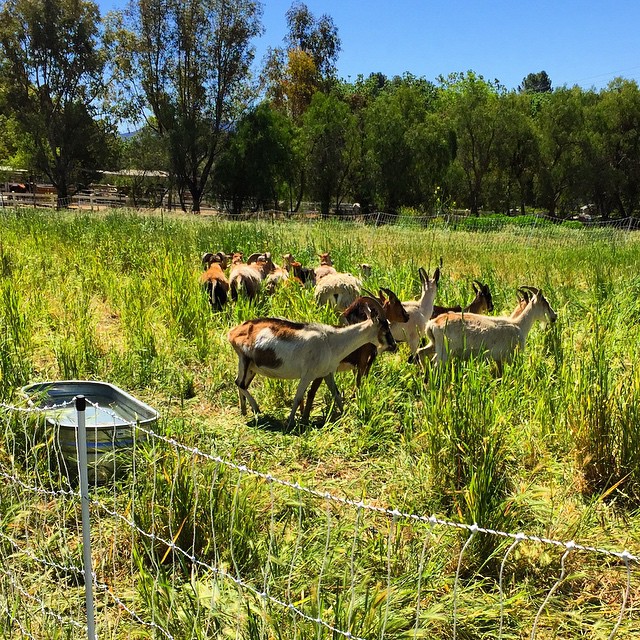This is What a Farmers Market Farmer is Really Like (and It’s Awesome)

The farmers market is a weekly display of edible eye candy: Fresh produce, flowers and – okay, fine – baked goods. But it’s more than just visuals; it can be a mental feast as well–for those who ask vendors the right questions.
Nate Peitso is one of those vendors.
Known best as owner of Agoura Hills’ Maggie’s Farm, Peitso has made the earth his life’s work. He’s been working at farmers markets since the tender age of 12 and, today, he’s continued that momentum by working with both of his parents on maintaining family farms. His efforts don’t end there, either. He’s working on opening a vertically-integrated restaurant with a friend, where he will provide 100 percent of the produce on the menu.
Despite his busy schedule, we were able to get a hold of Nate and ask him about what he does (check out his Instagram photos for a great peek into his version of “day-to-day”), and what drives him.
Organic Authority: I read somewhere that you learned how to farm from your parents. What made you want to decide to keep the family farm going?
Nate Peitso: It’s the only thing I’ve ever really enjoyed as a career. It’s really rewarding. I started at farmers markets when I was 12, and before that, I was doing “kid-style farming”: things that I could do, or be trusted to do as a youngster. But once I started making friends with people at the farmers market, selling produce every week and feeling the community, I felt like, “This is good. I’m doing good.” It makes me feel good. People love what we do, and they’re healthy because of what we do, and it felt like my place in the world.
OA: Tell me a little bit about your non-farming background. Did you go to school for this? What else do you like to do?
NP: I didn’t go to school for anything else. I studied German at community college in Santa Monica, and that wasn’t going to be anything I was going to do for a living; I just wanted to learn my ancestral tongue. I was never very good in school. I was always cutting class and not very interested in what was being said. I guess I always knew I was going to be a farmer, so I knew that the experience I was getting while farming was the most valuable to me. Running the farmers market for my parents was the first responsible job that I had. Then, my father retired in 2007, and I took over his farm [Maggie’s Farm] completely. That was when I was full-time, by myself farming.
Kenter Canyon Farms – that’s [my mom, Andrea’s] farm – is a family business. I’m involved in it, and I plan on moving into that one, as well, and running it.

OA: There’s a real health crisis happening in the U.S. What do you think is making it so hard for people to adopt healthy and eco-friendly eating habits? Is it really all about the expense? Or is it a lack of information? A supply-and-demand issue?
NP:For a long time, we were, as a society, pretty sustainable. People cooked their meals, people grew in their back yards things that they couldn’t afford to buy. We’ve gotten away from that with the convenience culture that came in with what I think was the industrial revolution. Everything had to be easier and easier, and farther and farther away from our roots. That industrialized our food system. People want to have ready-made product, and they don’t really care where it comes from. It’s very cost-effective to grow, for example, grain on a million acres when you can automate the whole thing. You end up being able to charge a lot less. People have become really accustomed to that, and they might eat things that were harder to come by. Grains were a really precious thing. Now, they’re in everything. Corn is the same thing. You could’t get it year-round. It was a speciality; something over the season. Now it’s ubiquitous.
People are waking up to it, because there are all kinds of health problems showing up: Things that weren’t an issue even 50 years ago are becoming epidemics, like obesity and diabetes, which comes from a basic level of unhealthiness in our society. For those with means, it’s a very easy problem to fix, because there are farmers growing great stuff, year-round. But, it’s expensive, because we’re on a smaller scale. The real problem is getting it to everybody.
The farmers market is still one side of the niche. You can use food stamps at the farmers market, and my farm offers a 50 percent credit; we double the value of food stamps, which definitely helps. We’re taking it another step; probably next year, we’re going to start this program with the Hollenbeck Police Department, where all of our leftover produce – things we don’t sell – will be at a heavily-subsidized farmers market in east L.A., near the police station. It’ll be something like a head of cabbage for a nickel. We have huge overrun. We’re trying to start with something like that, and I think there will be a lot of followers in that direction. I’m also associated with the Farm-to-Kitchen Foundation. Food that was wasted before, that maybe ended up in our compost pile or in the trash, is now going to be feeding people who really need access to healthy produce. We’re trying to equalize the availability of good food for our population. Obviously, I’m not going to single-handedly feed everybody, but I count.
OA: What’s your outlook on food? Are you optimistic? Curious?
NP: I’m bullish. I think food is going to become more and more important, especially as we’re running out of water in California. People are going to realize that lawns are a lot less important than agriculture, because you need to feed yourself. In L.A., we can grow our own stuff year-round. It’s going to have to switch to smaller-scale agriculture, and smarter agriculture. Our method of farming, where we use drip irrigation – which is just a little drop for every root ball – only irrigates the area that needs to be irrigated. When we switched to that, we were saving something like 90 percent of our water. There’s plenty of water. You just have to be smart about it.
OA: Where else in the country – and maybe, in the world, do you see the same efforts happening? And despite the push for family farms and real food in California, there’s a frustrating socioeconomic disconnect that doesn’t allow for widespread access to or education on what’s happening. What’s your experience with that?
NP: Israel is a great example for agriculture. That’s where drip irrigation comes from. They’ve been making the desert bloom, which is basically where we are, too: We’re in the desert, with a Mediterranean climate. Tuscany has some of the most advanced greenhouses and agricultural practices in the world. It’s the Mediterranean climate that’s really the best for agriculture. On the east coast, in New York and Massachusetts, there are some really outrageous farms that are doing some really wonderful things. Obviously, they have seasons to deal with, so laying ground fallow for somebody who has a hard winter is no problem, because half the year, you can’t grow in it. In California, we have the means, the labor force, and the market to really do a good job with agriculture year-round.
There is a huge disconnect. It’s the haves and have-nots. Obviously, the haves are more in tune with their health, in large part, because they have access to good healthcare. Part of that is access to the information that a better diet full of fruits, vegetables and less processed foods is better for your health. They have the time and the wherewithal to deal with that. The farmers market is a really great area because it’s there every single week. People who have any interest at all, no matter what they’re economic situation, can come and ask questions. I know a fair amount about it. I’m certainly no authority, but I’m a good place to start if somebody’s interested. Getting people interested has to be somehow brought into the mainstream. An ounce of prevention is worth a pound of cure. People need to be educated at an early age, “Eat well. No, seriously, eat well. It’s a lot better than taking insulin.” We might be starting that, but there’s a lot of pushback. There are a lot of very powerful companies and people that benefit from the status quo. I’m not a conspiracy theorist, but it is odd that we know for a fact that there’s a healthier way to do it, and we’re not teaching our children that.

OA: Where do you stand on the GMO debate?
NP: I’m not against GMOs. I think that a lot more testing needs to be done. I think it needs to be completely scientific and long-term testing to make sure we’re not destroying our environment.
OA: What has been the most exciting or inspirational thing that’s happened to you, or that you’ve witnessed as a farmer?
NP: The most exciting thing is working on new projects, like the vertically-integrated restaurant. That’s changing the paradigm, because a lot of the money produced by agriculture gets eaten up in the buying and selling of it. So we can offer a better price to the end user, and capture a larger profit for ourselves, all while providing local food to local people.
Being able to extend my crop cycle. We grow tomatoes now year-round, using old greenhouses and new technology. That sort of thing is just amazing to me.
And, feeding families at the farmers market. That’s the other thing. There are so many examples of young, single people who met at the farmers market who started showing up together, and now they’re married, and then they have a baby. That just makes me feel so good. I love that. Here I am, supplying to a whole family. I’m a part of that. That’s exciting. That keeps me going.
Related on Organic Authority
Oh, This? Just a Bunch of Small-Scale Farmers About to Save the Human Race [Video]
Does Hitting ‘Peak Farmers Market’ Mean We’re Running Out of Local Food?
USDA Makes ‘Historic’ $78 Million Investment in Local Food Systems
Image: Maggie’s Farm Instagram

